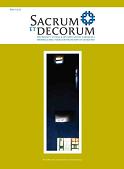Działalność Franciszka Białkowskiego i Władysława Skibińskiego. Przyczynek do badań nad działalnością warszawskich pracowni witrażowniczych
The activity of Franciszek Białkowski and Władysław Skibiński. A contribution to the research on the work of Warsaw stained-glass studios
Author(s): Danuta Czapczyńska-KleszczyńskaSubject(s): Cultural history
Published by: Wydawnictwo Uniwersytetu Rzeszowskiego
Keywords: Franciszek Białkowski; Władysław Skibiński; Warsaw; Poland; 20th c.; stained glass
Summary/Abstract: In 1902, a stained glass studio was established in Warsaw by Franciszek Białkowski and Władysław Skibiński. The cooperation between them soon ran its course and by1905, the two artists were already running two independent companies, producing stained-glass windows intended mainly for Roman Catholic churches throughout the Kingdom of Poland. “The Białkowski & Co. Artistic Stained Glass Studio”, awarded at multiple Polish and international exhibitions, produced figural and decorative stained glass designed by the owner himself and by other artists, such as Jan Kanty Gumowski (Żyrardów), Konrad Krzyżanowski (Brześć Kujawski, Limanowa), Eligiusz Niewiadomski (Konin), Jan Henryk Rosen (Lviv, the Armenian Cathedral and the Church of St Mary Magdalene), Edward Trojanowski (Lubraniec). The atelier was closed down in c. 1930. We only know of a few sacred stained-glass decorations produced by the other workshop discussed in the article, the “Skibiński Artistic Stained Glass Studio” (Kalisz, Czarnia, Opatówek, Mełgiew, Czarnożyły. Ciechocinek). At least some (e.g. those in Kalisz) were designed by Skibiński himself; the only designer known to have collaborated with the workshop was Włodzimierz Tetmajer (the “Under the Eagles” Chapel in Kalisz). The atelier was shut down in c. 1921, and its stock of glass was bought by the owner of the S.G. Żeleński Cracow Stained Glass Studio, who later frequently enlisted Skibiński’s services as an experienced stained-glass artist. The purpose of this article was to present preliminary conclusions concerning the two ateliers and to inspire scholars to conduct further research on the little known subject of the Warsaw stained-glass industry in the 1st half of the 20th century.
Journal: Sacrum et Decorum. Materiały i studia z historii sztuki sakralnej
- Issue Year: 2012
- Issue No: 5
- Page Range: 63-86
- Page Count: 24
- Language: Polish

